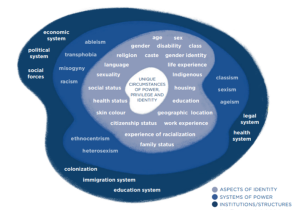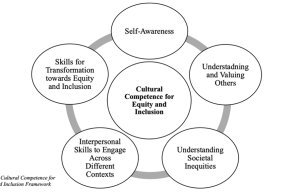12 Chapter 12 – Cultural Competence
Cultural Competence
Cultural competence includes patterns of awareness and communication that help you effectively coordinate interactions with others. This set of skills is rooted in understanding that each individual brings unique thoughts, experiences, and perspectives to a community or organization. The ways people are different encompass a  broad range of factors, including personal history, cognitive styles, race, ethnicity, nationality, gender, sexual orientation, age, socioeconomic status, physical abilities, and religious beliefs. These differences shape how people understand themselves, communicate, and interpret experiences. Kimberlé Crenshaw’s concept of intersectionality highlights how multiple identities (e.g., race, gender, sexuality, nationality) intersect and influence individuals’ experiences and societal interactions. What is important to understand about intersectionality is that rather than viewing people through one lens (i.e., white male) and extrapolating it to everyone, we work instead to understand how people’s unique combinations of characteristics influences not only their own behaviour but society’s behaviour towards them in terms of everything from interpersonal relations to systemic policy.
broad range of factors, including personal history, cognitive styles, race, ethnicity, nationality, gender, sexual orientation, age, socioeconomic status, physical abilities, and religious beliefs. These differences shape how people understand themselves, communicate, and interpret experiences. Kimberlé Crenshaw’s concept of intersectionality highlights how multiple identities (e.g., race, gender, sexuality, nationality) intersect and influence individuals’ experiences and societal interactions. What is important to understand about intersectionality is that rather than viewing people through one lens (i.e., white male) and extrapolating it to everyone, we work instead to understand how people’s unique combinations of characteristics influences not only their own behaviour but society’s behaviour towards them in terms of everything from interpersonal relations to systemic policy.
Although people differ in various ways, cultural differences are especially impactful, as they deeply influence communication patterns and perspectives within a community or organization. Culture, defined as the shared beliefs, values, customs, and behaviors within groups, acts as an invisible set of glasses influencing people’s perspectives and interactions (Yoshida & Fisher-Yoshida, 2015, p. 240). Cultural lenses affect everything from personal priorities to how people perceive and respond to the world around them.
Everyone views the world through their own cultural lens
The first step in developing cultural competence is to acknowledge that everyone views the world through their own cultural lens. Much like having an invisible set of glasses that shapes every experience, people are often not fully aware of how their cultural background influences their perspectives and behaviors. The saying, “the last one to discover water was the fish,” aptly illustrates this concept: just as fish may not realize the water surrounding them and what that enables and constrains (e.g., how they breathe, what food they eat, who their neighbors are, or how they interpret normative behaviors and threats), people may not recognize the cultural influences shaping their lives. Understanding your culture can be a bit of a thought exercise. For example, you might not think much about “North American office culture” until you read a paragraph describing how we tend to behave in offices. For example, sometimes we have “casual Fridays” where people wear jeans, often people bring their lunch to work but sometimes they eat at their desk instead of taking a break to join colleagues, we call our boss by their first name, anyone can speak in a meeting without regard to rank or hierarchy, etc. To someone from a different culture, these ideas might seem scandalous.
 Understanding that culture functions as an invisible lens can help you become aware of your own biases and perspectives. This awareness helps you question and avoid assumptions based on your own cultural norms and enables more thoughtful engagement with diverse perspectives. Cultural humility, which involves a commitment to ongoing self-reflection and learning about other cultures, emerges from this awareness. It’s not just about acquiring cultural knowledge, but also about applying it to create an inclusive and respectful environment.
Understanding that culture functions as an invisible lens can help you become aware of your own biases and perspectives. This awareness helps you question and avoid assumptions based on your own cultural norms and enables more thoughtful engagement with diverse perspectives. Cultural humility, which involves a commitment to ongoing self-reflection and learning about other cultures, emerges from this awareness. It’s not just about acquiring cultural knowledge, but also about applying it to create an inclusive and respectful environment.
Your identity is a multifaceted concept that encompasses the characteristics, traits, and experiences that define who you are. It includes your values, beliefs, and traits along with things like age and sexuality. It also involves the groups you belong to, such as your nationality, ethnicity, religion, and social class along with the cultural norms, traditions, and values, Additionally, it includes the roles you identify with like friend, sibling, and your professional identity. It’s a delicate balance to stay true to ourselves while also respecting and adapting to the diverse environments we are part of. Furthermore, organizational and social structures often value some identity elements more than others. This can lead to certain identities being privileged while others are marginalized. How we navigate and respond to these dynamics is tricky. It has ethical repercussions as it is important to ensure that everyone has the opportunity to express themselves authentically and be valued for who they are.
Cultural competence in the workplace involves understanding, respecting, and appropriately responding to the unique differences and similarities that individuals bring to the workplace.
Navigating your own identity in tandem with unique individuals and diverse cultural norms requires self-awareness and sensitivity, as well as a willingness to learn and grow. By learning and managing these differences you are best positioned to communicate and coordinate with others. Ultimately in the context of work and the workplace, cultural competence involves understanding, respecting, and appropriately responding to the unique differences and similarities that individuals bring to the workplace.
Framework to help think about it
 This model of cultural competence for equity and inclusion developed by Diane J. Goodman, Ed.D. (2014) can be helpful to understand and develop cultural competence. It illustrates that structures can influence how we think about, and interact with, different cultures. It also shows where attitudes and skills can help address the complexity of interacting across differences.
This model of cultural competence for equity and inclusion developed by Diane J. Goodman, Ed.D. (2014) can be helpful to understand and develop cultural competence. It illustrates that structures can influence how we think about, and interact with, different cultures. It also shows where attitudes and skills can help address the complexity of interacting across differences.
By working on these areas, you can enhance your cultural competence, making you more effective in diverse environments and better equipped to contribute to equity and inclusion efforts.
Application
Organizational structures such as policies, hierarchies, power dynamics, leadership, culture, and group structures intersect with cultural differences in significant ways. Policies that fail to account for diverse cultural needs can inadvertently disadvantage certain employees. Hierarchical structures may limit the ability of lower-level employees from different cultures to voice their concerns, while power dynamics can affect how cultural challenges are addressed. Leadership styles that lack cultural awareness may perpetuate biases, and an organizational culture that does not embrace diversity can create an unwelcoming environment. Additionally, group structures can either exacerbate or mitigate cultural conflicts within teams.
Cultural competence helps navigate these intersections effectively. By understanding and respecting cultural differences, you can advocate for more inclusive policies, address power imbalances, model inclusive leadership behaviors, and contribute to a welcoming organizational culture. In terms of aspirational communication, cultural competence allows you to communicate in ways that not only respect and acknowledge differences but also aspire to create inclusive and equitable environments.
Here are some key steps to help you enhance your cultural competence:
- Reflect on your own cultural background, biases, and assumptions. Understanding your own identity and how it influences your perceptions and interactions is the first step toward cultural competence.
- Actively seek out information about different cultures. This can include reading books, attending workshops, watching documentaries, or engaging in conversations with people from diverse backgrounds.
- Practice empathy by trying to understand and appreciate the experiences and perspectives of others. Approach cultural differences with an open mind. Engage in meaningful conversations and activities that allow you to learn from each other and build mutual respect.
- Develop communication skills that are respectful and inclusive. This includes being mindful of both verbal and non-verbal cues and being open to feedback.
- Actively work to recognize and challenge stereotypes and biases, both in yourself and in others. This involves questioning assumptions and being open to new perspectives.
- Support and advocate for policies and practices that promote equity and inclusion. Be an ally to marginalized groups by standing up against discrimination and promoting inclusive practices.
References
Project READY: Reimagining Equity & Access for Diverse Youth (2024). Module 8: Cultural Competence & Cultural Humility. https://ready.web.unc.edu/section-1-foundations/module-8/
Condon, J. and LaBrack, B. (2015). “Definition of culture.” In J.M. Bennett (Ed.) SAGE encyclopedia of intercultural competence (191-195). SAGE Publications, Inc.
Deardorff, D.K. (2015). Definitions: Knowledge, skills, attitudes. In J.M. Bennett (Ed.) SAGE encyclopedia of intercultural competence (217-220). SAGE Publications, Inc.
Heckroodt, S., & Ghanem Al Hashmi, W.S. (2023). Cultural Competence: The Intrinsic Strategic Advantage. Routledge.
Kuper, A., Veinot, P., Leavitt, J., Levitt, S., Li, A., Goguen…Whitehead, C. R. (2017). Epistemology, culture, justice and power: Non‐bioscientific knowledge for medical training. Medical Education, 51(2), 158–173.
Sue, D. W., & Spanierman, L. (2020). Microaggressions in everyday life (2nd ed.). John Wiley & Sons, Inc.
Supplementary Readings
CCOHS. (n.d.). Diversity, equity, and inclusion in the workplace. Government of Canada. https://www.ccohs.ca/oshanswers/psychosocial/diversity-equity-and-inclusion-in-the-workplace.html
Harvard Business School [username]. (2024, February 23). Rethinking diversity, equity, and inclusion: Moving beyond the business case approach. YouTube. https://www.youtube.com/watch?v=owaN9B9dhMw
Southbank Centre [username]. (2016, March 14). Kimberlé Crenshaw: Intersectionality and gender equity. YouTube. https://www.youtube.com/watch?v=-DW4HLgYPlA
University of Pennsylvania. (2023, March 22). DEI in the workplace: Why it’s important for company culture. Penn LPS Online. https://lpsonline.sas.upenn.edu/features/dei-workplace-why-its-important-company-culture
